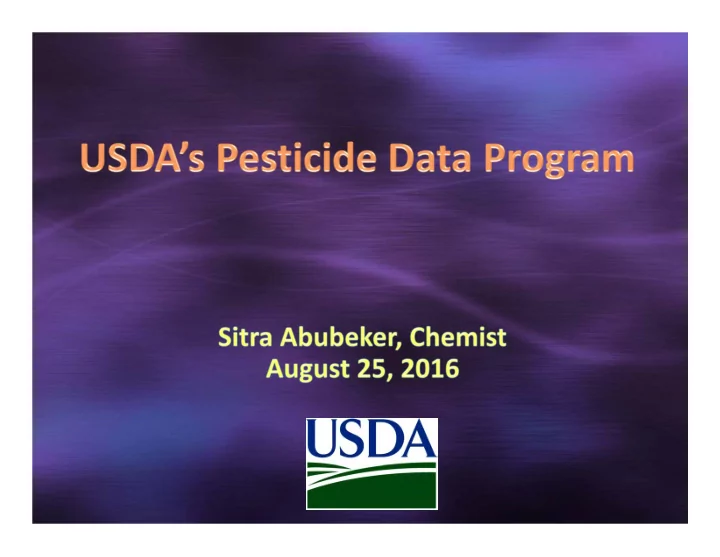

National Pesticide Residue Program PDP samples and tests highly consumed foods with emphasis on the diets of infants and children for pesticide residues Sampling and testing performed by State Department of Agriculture cooperators Funded through Cooperative Agreements with the States
Created in 1991 to collect pesticide residue data in fresh produce in support of the Food Quality Protection Act of 1996 Provides data for dietary risk assessments and pesticide reregistration decisions to the Environmental Protection Agency (EPA)
PDP Participants Washington Michigan Vermont Massachusetts Idaho Wyoming Connecticut New Jersey Ohio Nevada Delaware Colorado Maryland California Missouri North Oklahoma Carolina New Mexico Texas Florida Alaska Location of participating State (black stars) and Federal (red stars) Hawaii Laboratories States where produce is directly marketed States participating in PDP from participating States
Commodity and pesticide selection: AMS and EPA/HED Foods tested are usually high consumption commodities Analytes tested are based on registrations
Lab results Results Samples Participating entered into approved by All results Sampling sent to States Remote Chemist at compiled schedule assigned collect Data Entry MPD to be into Annual generated labs for samples (RDE) entered into Summary analysis system database
Number of Commodity Type Commodities Fresh Fruit and Vegetables 48 Processed Fruit and Vegetables 36 Grains 8 Meat/Poultry/Fish 9 Dairy 4 Nuts 2 Water 4 Infant Formula 2 Total Number of 113 Commodities Tested Total Commodities from 1991‐2015 7
Residues in Baby Food (2012‐2013) Residues in Infant Formula (2013‐2014) Bifenthrin Use for Stinkbugs (2012) Control Brown Marmorated Stink Bug Section 18 Emergency Use granted based on PDP data 8
Apple Pears Potatoes Spinach Strawberries Sweet potato Tomatoes Oranges Cherries Cucumbers Grapefruit Grapes Green beans Lettuce Milk Egg
Commodities in program for up to 2 years Rotation of high consumption items every 5 years New commodities based on data needs requested by EPA Sampling rates/timeframes adjusted to reflect seasonality
NASS designs the sampling framework based on probability‐ proportional‐to‐size Represents U.S. population and therefore reflects consumption Random sampling: includes domestic & imported, organic & traditionally‐grown foods Fruit and vegetable sites at major food distribution centers and terminal markets
Number of samples collected is apportioned according to population 63 total samples per commodity per month Equates to 756 total samples targeted per commodity per year California 13 New York 9 Colorado 2 N. Carolina 4 Florida 7 Ohio 6 Maryland 4 Texas 8 Michigan 6 Washington 4
QuEChERS Qu ick E asy Ch eap E ffective R ugged S afe
Test for over 400 pesticides/metabolites/ isomers using Multiresidue Methods (MRMs) Lists of required compounds are commodity‐specific GC/MS‐MS and LC/MS‐MS Instrumentation
Pesticide Classes : Carbamates Phenoxy acids (2,4,5‐T; 2,4‐D, Chloroacetanilides (alachlor, etc.) Pyrethroids (allethrin, bifenthrin, acetochlor, etc. Imidazolinones (imazapyr, etc.) Strobilurins (azoxystrobin, imazaquin, etc.) Neonicotinyls (acetamiprid, kresoxim‐methyl, etc.) Sulfonyl ureas (bensulfuron clothianidin, etc.) Organochlorines methyl, halosulfuron, etc.) Organophosphates Triazines (atrazine, simazine, etc.) Triazoles (difenoconazole, hexaconazole, etc.)
Method validation is required for each new commodity and pesticide. Blanks, spikes, and process controls are run with each sample set. Limits of detection (LODs) and limits of quantitation (LOQs) are determined experimentally. Participation in National and International Proficiency Testing is required. International accreditation is required (ISO 17025) for all laboratories. 16
Custom built software that feeds Data to PDP Database ‐ Two Major Components RDE electronic Sample Information Form (e‐SIF) System Used by State Sample Collectors to enter and submit e‐SIFs Web–based RDE System Used by PDP Labs to enter and submit complete data sets Software and database reside on USDA‐AMS servers All data is collected and compiled into an Annual Summary.
In 2014, a total of 10,619 samples were tested Pesticides exceeding the tolerance were detected in 38 samples (0.36%) 19 of these 38 samples were imported Pesticides with no tolerance established were detected in 281 samples (2.6%) 140 of these 281 samples were imported PDP is not an enforcement program Presumptive Tolerance Violation information is passed to FDA and EPA for potential follow‐up
Pesticide tolerances evaluated by EPA using PDP data Pesticide re‐registration or cancellation based on outcome of tolerance evaluations Monitor compliance with U.S. EPA tolerances (MRLs) Tolerance violations reported to FDA for surveillance Work with grower groups to improve agricultural practices PDP data used by Foreign Agricultural Service to resolve trade disputes 19
Annual Summary Website Hard Copy Downloadable Database Data for specific commodity and pesticides http://www.ams.usda.gov/AMSv1.0/pdp 20
Recommend
More recommend